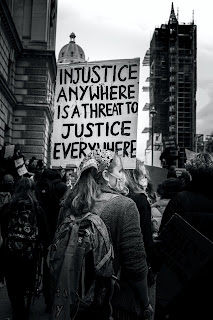Day 22 – Changing language a few sentences at a time
 |
| Photo by Avel Chuklanov on Unsplash |
In reading back over my promotion essay I’m struck by how my own perspective keeps getting clearer… I’m including a section of my essay below. I’m struck by my edits of the last sentence. In this sentence I say “I have begun to also see the importance of viewing these early theories through a critical lens…” And I speak about “the development of the arts as a healing tradition.” I would no longer frame our theories and work as “the development of the arts as a healing tradition.”
The arts as a healing tradition exists. We (expressive arts therapists) have not “developed” it. I’m not even sure what place the “healing traditions of the arts” have in our modern “field of expressive arts therapy.”
How do I contextualize the modern profession of “expressive
arts therapy” as a profession involving “therapy?” And what relationships do our American conceptualizations of "therapy" have with modern and past "healing traditions?" Is this just another form of "cultural appropriation?"
For those of us who are also licensed as “mental health counselors” there is even more obligation to understand the context of our role as “therapists.” Ok… so I’ve changed the last sentence… what do you think?
***
Lesley University houses the only degree-granting program in the world where music therapy, art therapy, dance therapy, drama therapy and expressive arts therapy reside within one department, the division of Expressive Therapies. As an early graduate of our program (I graduated from our Expressive Therapies master’s program in 1984), I represent a whole generation of expressive arts therapists who studied under a model primarily grounded in an experiential understanding of an integrated arts approach, rather than a theoretical approach. Experiential learning served as the primary focus in large part because expressive arts therapy did not begin to amass a body of literature outlining theory and practice until the 1990s. During the last few years, much of my core teaching reflects an inclusion of newer theoretical approaches to complement the experiential learning that still lies at the hearts of our pedagogy.
Shaun McNiff, the founder of the program, to this day maintains that he has not promoted a theoretical model of expressive arts therapy but rather promoted the uncontestable medicines (“healing and reconstructive powers”) of creative imagination in all their forms of expression.[1] Paolo Knill, one of the founding expressive arts therapy faculty, began to articulate his model of “intermodal expressive therapy” during the 1980s, offering students excerpts from his doctoral thesis for course readings (he did not publish his first “text” on this approach until 1995).[2] Due to Knill’s major influence within the program and the profession, many alumni and adjunct faculty still refer to the specialization as the “intermodal” track at Lesley. Despite Knill’s prominence, at Lesley and throughout the world, other models and approaches to expressive arts therapy began to take root.
By the late 1990s and early 2000s, as a range of theoretical approaches to expressive arts therapy began to emerge, I started to look for ways within my classes and writing to articulate this solidification of our field. I count as one of my contributions to the field, and to our specialization, an appreciation for multiple approaches and an articulation of a range of theoretical perspectives. In 2005, I wrote a chapter for a text on expressive therapies that outlined this integrative arts therapy field, and that described four foundational theoretical approaches.[3] I did not, however, offer a critique to these emerging theories; instead, I saw my role as summarizing and synthesizing the few theories which were gaining prominence. McNiff’s theory of arts as medicine, Knill’s theory of intermodal expressive therapy, and Natalie Rogers’ theory of the creative connection (a person-centered expressive therapy model based on an expansion of her father, Carl Rogers’ humanistic approach) were the cornerstones of my description of expressive arts therapy. I also included a developmental model, the expressive therapies continuum, which seemed applicable to a transdisciplinary articulation.
I wanted to formally outline the theoretical foundations of our field rather than define a new approach, and I wanted to highlight Lesley University’s role in the field. As the years have progressed however, I have begun to also see the importance of viewing these early theories through a critical lens that acknowledges institutional and societal structures of power and oppression, and that acknowledges the importance of recognizing previously marginalized voices in the development of the field of expressive arts therapy.
[1] McNiff, S. (2017). Cultivating imagination. In E. G. Levine & S. K. Levine (Eds.), New developments in expressive arts therapy: The play of poiesis (pp. 21-30). London and Philadelphia: Jessica Kingsley Publishers.
[2] Knill, P., Barba, H., & Fuchs, M. (1995). Minstrels of soul: Intermodal expressive therapy. Toronto: EGS Press.
[3] Estrella, K. (2005). Expressive therapy: An integrated arts approach. In. C. Malchiodi (Ed.), Expressive therapies (pp. 183-209). New York: Guilford Press.



Comments